| Article ID | Journal | Published Year | Pages | File Type |
|---|---|---|---|---|
| 4386388 | Biological Conservation | 2009 | 8 Pages |
Ex situ conservation of animal populations may benefit from captive-breeding programmes, but these are criticised because they are assumed to be difficult, time-consuming and expensive, while they do not guarantee success. However, such assumptions remain untested in most organisms; for example, introductions could be very useful for recovering populations of small-sized species with short generation time, no learned behaviours, and ease to rear in captivity. Here, we document an easy, cheap and successful reintroduction programme of the lacertid lizard Psammodromus algirus. Two captive-bred cohorts (178 juveniles in 2001 and 187 in 2002) were released in four woodland fragments (0.9–5.2 ha) at two localities (B and V); B housed a stable lizard population whereas V apparently lacked a viable population of lizards. We monitored introduced and native lizards during 2002 and 2003, and carried out a corroborative searching in 2006 which confirmed the existence of a lizard population at site V. Introduced lizards had higher activity and dispersed more frequently among woodland fragments than native ones. Survivorship and growth rates were similar for both groups, but introduced juveniles were about 25% larger than native ones, due to both early hatching and better rearing conditions. The whole procedure was easily implemented in our Faculty facilities (mean hatching and hatchling survival rates of 0.90 and 0.87), and cost less than 20,000 € (excluding salaries). Therefore, similar programmes may be of wide application in small animals and of practical importance for species with a meta-population structure living in fragmented landscapes.
